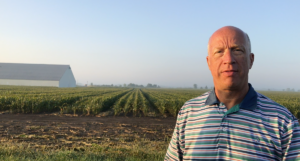Now’s the time when holiday enthusiasts start dreaming of a White Christmas. But the marshmallow world created by falling snowflakes offers much more than a glistening backdrop for a Hallmark movie. And nobody choruses “Let it snow, let it snow, let it snow” louder than farmers. In the northern states, snow can account for 2/3 of the annual precipitation. Melting snow replenishes subsoil moisture. And even though 10 inches of snow = 1 inch of rain, many Great Lake states can get several feet of snow annually. For crops that overwinter, such as winter wheat, a blanket of snow can insulate the crop, and often serve as mulch for the soil ecosystem. Pasture cattle will ingest much of their water from snow. Often called “poor man’s nitrogen,” atmospheric nitrogen will attach itself to falling snow, adding valuable nutrients to the field.
Oranges are popular stocking stuffers. But do you know how the tradition of gifting this tasty citrus started? Not surprisingly, with Saint Nicholas. Story has it that during his travels as a bishop, he met a shopkeeper with three daughters who couldn’t afford a dowry, which meant the girls would be destitute once their father passed away. St. Nick gave them three balls of gold by tossing them down the man’s chimney, where they ended up in the daughters’ stockings that were drying by the fire, thus giving the girls what they needed to live happily ever after. As years passed, people began to honor the story and St. Nicholas by gifting oranges.
Maybe farmers are just merrier this time of year, as farmer sentiment rose slightly again last month. Purdue’s Farm Financial Performance Index, which compares this year to last, rose to its second highest level this year, and 10% higher than the start of harvest. While crop input prices remain their biggest concern – 32% listed it as their top issue – it’s trending downward, reaching its lowest level of 2023. Reduced fertilizer prices are likely a key driver. Concerns over interest rates continue to grow, now listed by 26% of farmers as their chief issue. Earlier this year, concerns over crop input prices were nearly twice that of interest rates.
The world’s top wranglers and riders have assembled in Las Vegas this week for the National Finals Rodeo. That means RFD-TV will air night and day in my house, and Mike Boyd will make his annual pilgrimage to Sin City. NFR creates the perfect venue for marketing to western lifestyle enthusiasts, ranchers and farmers. Few entertainment properties have utilized the power of social media like rodeo. Many brand ambassadors and social media influencers have emerged and are in Vegas promoting apparel brands such as Ariat, Wrangler and Boot Barn on their Instagram, YouTube and TikTok channels. Stadium and TV signage are marketing brands such as Mahindra tractor, Massey Ferguson, Heston and Purina to ranchers.
Huma is sponsoring the Big Soil Health event this week in Cedar Falls, Iowa. I’ll be interviewed by WHO Radio today during the event.
Related Posts

This Week in Ag #32
Everyone remembers where they were on September 11, 2001. One of my most vivid memories was the week after. I was farming with my dad at the time. He had just started cutting soybeans in a field owned by my wife’s family, situated next to Interstate 74 in western Illinois. I was driving to the

This Week in Ag #28
The recent fertilizer market may be best described by two catch phrases: “wait-and-see” and “just in time.” In the fall of 2021, sky-rocketing energy prices pointed toward looming inflation and an inevitable rise in fertilizer prices. Many savvy growers, including those aligned with the regen ag movement, hedged their bets by purchasing crop nutrients that

This Week in Ag #35
Last week I was a guest on the TopSoil Webinar series hosted by Mitchell Hora of Continuum Ag (you can check it out here). I mentioned how western growers seem further along in their regenerative agriculture journey. That’s largely driven by regional attitudes and the food companies, who have pledged to sell products grown using regen ag practices. This has motivated growers of crops such as potatoes, onions, apples, and blueberries to hasten their adoption. But in the Heartland, where commodity crops fill the landscape, these growers have lacked many of the market-driven economic incentives. Until now.

